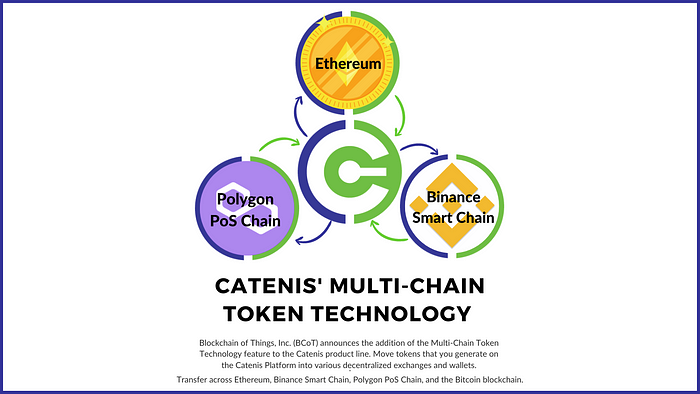Tokens on the Bitcoin Blockchain Now Provide Cross-Chain Flexibility

Blockchain of Things (BCoT), has developed the ability to allow digital assets to travel across multiple protocols. What does this mean for the industry and how does it work? If a token is created on Bitcoin (BTC), using the Catenis platform, those same tokens can be moved to Ethereum (ETH)/Binance Smart Chain/Polygon Proof of Stake (POS) Chain and moved back into Bitcoin.
Limitless Choices
For the very first time ever, once a token has been created on the Bitcoin Blockchain, it isn’t locked to the Bitcoin Blockchain. For example, if a project creates 100 tokens using the Catenis platform, these assets can be moved to other currently supported blockchains in any quantity.
One could move 30 to Binance, 20 to Ethereum, 30 to Polygon, and leave 20 on the Bitcoin Blockchain. Or one could move all of them from the Bitcoin Blockchain to one of the other three blockchains. The options and quantities one can choose are endless.
This functionality from Blockchain of Things is innovative to say the least, but BCoT goes even further. At any time, those exported tokens can be migrated back into the Bitcoin Blockchain.
Guarding Against Threats
The fall of companies like Celsius and FTX has devastated blockchains. Do Kwon’s algorithmic Terra stablecoin collapse destroyed Luna. This exposed a weakness in the sector that needed a solution.
The Catenis platform figured out the answer to guard against unforeseen external threats in the market: coins must be easily transferred.
If a chain of events threatens one blockchain, any coin on that blockchain is also threatened. However, tokens created through Catenis can be moved with just a few clicks and out of harm’s way.
Normally, moving an entire project from its originating blockchain, to another requires a massive amount of code, money, and time.
In the Defi space, BTC, ETH, BSC, and Polygon are crucial chains for mass-adoption. With bidirectional support, Catenis eliminates the biggest negative for most projects: being locked into only one blockchain or token type.
Types of Assets
Did you know tokens can be issued for any physical asset on the Bitcoin Blockchain? Once issued, these tokens, which represent stocks, bonds, real estate, art, gold, and rare gems, become easy to transfer and are immutable. The transparency adds to their utility.
Whether fungible or Non-Fungible Smart Assets, the tokens incorporated with intelligent edge-node programs (Smart Contracts) can trigger actions and events and act as intelligent inputs.
A Broader Audience Means Greater Potential
Each of the most popular chains — Bitcoin, Ethereum, Polygon, and Binance — enjoy incredibly loyal communities. The ability to promote to these groups of investors enhances the chances of adoption.
Global crypto ownership is estimated at 420 million users worldwide. The 7.5 billion who don’t own a single coin represent future growth potential.
Since Bitcoin (BTC) is the most widely recognized coin in the world, why not start with BTC?
Projects that build on the BTC Blockchain have a greater chance of reaching those who are new to the space, while the flexibility of choosing the other top chains makes the token appeal to existing cryptocurrency investors who are partial to ETH, Polygon, or Binance.
Additionally, as demand for other chains grows, Catenis will expand its list of compatible blockchains.
Ultimately, Blockchain of Things has successfully eliminated the biggest roadblock to blockchain adoption: interoperability across chains.
Best part? Crypto enthusiasts can get in on this exciting new adventure now! Get started with a free account here.
To learn more about this functionality, you can access the documentation at the following links:
2. Asset Export Admin Dashboard


